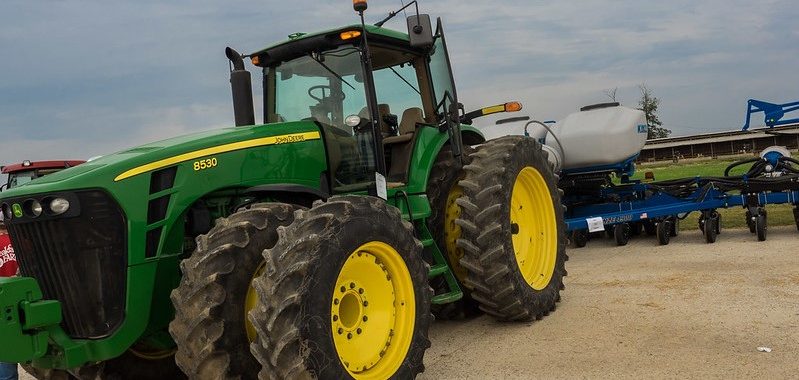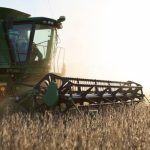Follow marking guidelines, rules of the road to ensure safety
MARSHFIELD, Wis. — Harvest is a high-risk time for crashes on public roads. The sun sets earlier each night and slow-moving farm equipment may not be well-marked or visible, sometimes lacking lights and reflective tape. Speed adds to the danger for motorists and farmers.
Additionally, as ownership of agricultural land continues to consolidate, farmers are on the road more hours and driving equipment longer distances, towing implements and products between field and farmstead.
“Roadway traffic isn’t likely to decrease in the coming decade, especially not in the rural communities surrounded by farming operations. Thus, we should all be proactively advocating for and enforcing the ‘rules of the road,’ ensuring tractors and agricultural equipment is property marked and lighted, and highly visible to motorists,” said Bryan Weichelt, Ph.D., associate research scientist and rural health informaticist studying agricultural injury surveillance at the National Farm Medicine Center and the National Children’s Center for Rural and Agricultural Health and Safety. Weichelt is also the project leader of AgInjuryNews.org, a growing collection of injury reports, often from news media, that provides a view of U.S. agricultural injury.
Since 2015, more than 200 incidents of farm equipment and motor vehicle collisions on public roadways have been recorded in the AgInjuryNews.org database. Those incidents resulted in 240 deaths and 135 non-fatal injuries.
“Any time people are dying it’s a serious problem, and in this case, many – maybe all – of the incidents are preventable,” Weichelt said.
The Wisconsin Farm Related Fatalities reports for 2017 and 2018 for the first time included incidents on public roadways. The reports compile statistics about agriculture-related deaths in the state. In each year, roadway deaths accounted for 29 percent of all farm fatalities (nine of 41 farm fatalities in 2017 and eight of 34 fatalities in 2018).
“It is not surprising that we see so many roadway deaths – both to farmers and the general public who share the road with famers and their machines,” said John Shutske, an Extension Agricultural and Health Safety Specialist at UW-Madison, commenting on the Wisconsin Farm Related Fatalities report. “Most people think of farm safety as an issue of personal choice, but in the case of highway collisions involving slower moving ag equipment, it really crosses into the domain of public safety and health.”
What’s been done to reduce crashes
A federal law containing the Agricultural Machinery Illumination Safety Act requires all agricultural implements manufactured after 2017 to be equipped with roadway lighting and marked in accordance with the most current engineering design standards. But older equipment may not have even basic marking nor be required by state law to have it. Shutske wrote about this in an article for PDPW Dairy’s Bottom Line. For example, the federal law requires turn signals for agricultural equipment operated on roadways. Turn signals usually are integrated into flashing amber lights, which are required. But Wisconsin state law currently doesn’t require turn signals.
Shutske encourages farmers to upgrade equipment to meet recognized safety measures in the American Society of Agricultural and Biological Engineers standard S279, “Lighting and Marking of Agricultural Equipment on Highways.”
The slow-moving vehicle (SMV) emblem was developed and standardized, and new materials have been developed, such as LED lights and retroreflective tape that are relatively inexpensive and do not require electrical power, Shutske said.
Speed increases injury risk. “Injury risk is directly related to kinetic energy transfer, which means that the speed differential is deadly – double the speed difference, you quadruple the risk,” Shutske said. “If you approach a loaded wagon or other vehicle or a tractor and implement, you may as well be approaching a brick wall.”
Most farm equipment operates at speeds under 25 mph, and a motor vehicle has only seconds to stop before a crash may occur. A University of Madison-Extension article by Cheryl Skjolaas, Division of Extension agricultural safety specialist, notes any type of distracted driving – talking on cellphone, checking a text message, being tired – can make stopping without a crash almost impossible.
“It’s important to be alert and remember that these farm implements don’t behave like cars and pick-up trucks when it comes to speed, turning or braking,” she said.
Skjolaas notes that it is illegal to pass a farm implement or an agricultural commercial motor vehicle in a no passing zone. Motorists are responsible for passing safely and ensuring there aren’t driveways into farms or fields, intersections or roadway structures that will cause the farm implement operator to change road position.
What more can be done to improve safety
Shutske says complying with minimum state requirements isn’t enough. He would like agriculture operators to follow federal guidelines to make equipment visible to drivers and for state laws to be clear and concise.
“Operating farm equipment on any public roadway is a potentially dangerous activity for producers and other drivers,” Shutske wrote in the PDPW article. “Take advantage of new technologies on the market, including excellent-visibility light-emitting-diode lighting, inexpensive reflective materials, turn signals and more. Though the inconsistencies between state and federal laws can be confusing, compliance with the current version of standard S279 is the best bet to effectively improve highway safety.”
Weichelt encourages education and regulation.
“Equipment needs to be properly marked, and operators should be ticketed when it’s not,” he said. “It’s one of the few areas where agricultural safety regulation exists and is enforceable – on public roadways. We wouldn’t drive with a headline or taillight out on our car or truck, so why take the tractor down the road at dusk without any lights at all? The choice to do so puts others’ lives at risk as well – there are many cases where others are injured or killed colliding into unmarked agricultural equipment.
“It’s about caring for your neighbor, your friends,” Weichelt said.
Safety tips for motorists
Skjolaas offers tips and reminders for motorists during the fall harvest season:
- Look for lighting and marking on the farm implements. Farm machinery that usually travels less than 25 miles per hour (mph) is required to display a “slow moving vehicle” or SMV emblem on the back. It is an orange and red triangle visible to the rear on either the left side of the tractor or towing implement or the rear most towed vehicle.
- Keep a safe distance. The farm vehicle operator may not be able to see around the equipment, so don’t assume that the operator knows you are approaching. Similar to semi-trucks, many use large extended mirrors. When a driver follows too closely, the vehicle isn’t visible to the farm equipment operator.
- Check for turn signals. On farm tractors or self-propelled machines like combines, the flashing lights are also turn signals. When following slow moving machines for a distance, it is easy to miss that operator has signaled for a turn. Watch for the operator to use a hand signal when signal lights are not present.
- During hours of darkness and low-light situations when visibility is less than 500 feet, turn your headlights on.
- Farm implements may travel on roads where they are normally not expected. For example, farmers may use local streets or highways to transport grain to storage facilities.
- Watch for a yellow and black road sign with the symbol of a farmer driving a tractor. These signs are within 500 feet of a driveway to alert motorists of a farm or field drive with an obstructed view such as on a hill or around a curve.
Last modified: 10/15/2020













